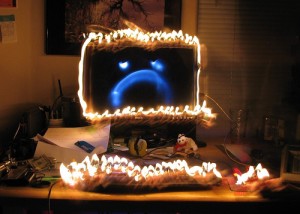On May 8, 2015, the Trademark Trial and Appeal Board (TTAB) sustained the New York Yankee’s opposition to the registration of three marks because they were likely to dilute by blurring some of the New York Yankees’ famous marks.
The case is interesting because the TTAB firmly stated that the fair use defense in trademark dilution cases, provided by the Trademark Dilution Revision Act, cannot succeed if Defendant’s use is commercial.
IET Products and Services, Inc. (Applicant) was seeking to register “THE HOUSE THAT JUICE BUILT” in class 25 for “T-shirts, baseball caps, hats, jackets and sweatshirts,” THE HOUSE THAT JUICE BUILT in class 21 for “Mugs”, and a design mark showing a top hat atop a syringe. As the TTAB did, we will consider THE HOUSE THAT JUICE BUILT to be one mark, regardless of the quote marks.
The New York Yankees (Opposer) claimed that these three marks were likely to cause dilution by blurring of its design mark featuring a top hat atop a baseball bat and THE HOUSE THAT RUTH BUILT mark.
Dilution by Blurring
Dilution by blurring is defined by Section 43(c)(2)(B) of the Trademark Act as an “association arising from the similarity between a mark or trade name and a famous mark that impairs the distinctiveness of the famous mark.” Such dilution can occur even in the absence of confusion or likelihood of confusion, Section 43(c)(1). It suffices that a substantial percentage of consumers are reminded of the famous mark when seeing the junior mark, even if they understand that the origin of the goods or services is not the famous mark.
The Court of Appeals for the Federal Circuit enumerated in Coach Servs. Inc. v. Triumph Learning LLC four factors which must be proven to prevail in a dilution by blurring claim:
(1) the plaintiff “owns a famous mark that is distinctive;
(2) the defendant is using a mark in commerce that allegedly dilutes the plaintiff’s famous mark;
(3) the defendant’s use of its mark began after the plaintiff’s mark became famous; and
(4) the defendant’s use of its mark is likely to cause dilution by blurring or by tarnishment.”
First Factor: Fame
Section 43(c)(2)(A) of the Trademark Act considers that a mark is famous “if it is widely recognized by the general consuming public of the United States as a designation of source of the goods or services of the mark’s owner.” Courts may use four non-exclusive factors to determine if a mark is famous, which are:
- The duration, extent, and geographic reach of advertising and publicity of the mark.
- The amount, volume, and geographic extent of sales of goods or services offered under the mark.
- The extent of actual recognition of the mark.
- Whether a mark is registered.
The TTAB found the Top Hat Logo design mark of the New York Yankees to be famous for dilution purposes. The mark has been used for more than 50 years and is displayed at Yankees Stadium during the team home games, which have been broadcast on several national networks, such as ESPN or ABC, on the MLB Network. The mark has also been used in connection with sponsorship with other brands, such as Pepsi-Cola, and has been also used on apparel and on the Yankee’s uniforms.
The TTAB also found THE HOUSE THAT RUTH BUILT mark to be famous for dilution purposes. This mark refers to the original Yankee Stadium in New York, which was nicknamed as such after Babe Ruth joined the team in 1920, shortly after the opening of the stadium, and drew huge crowds there because of his slugging abilities and his huge personality. Opposer introduced as evidence some 2,600 newspaper articles published from 2000 to 2007 containing both “Yankees” and “the House that Ruth Built.” The TTAB found it to be “strong evidence not only that the public and press have come to view THE HOUSE THAT RUTH BUILT as an indicator of source for Opposer … but also that it is a famous mark.” The first dilution element is thus satisfied.
The TTAB found that Applicant used its mark in commerce, as an application based on intent to use a mark in commerce under Trademark Act Section 1(b) satisfies the commerce requirement under the Trademark Dilution Act, and thus the second dilution factor was satisfied. Under the third dilution factor, Opposer had to prove its marks became famous before Applicant filed its intent-to-use application. This was the case here, and the third dilution factor was satisfied. The marks were registered, and so the fourth factor was also satisfied, and the TTAB found both Opposer’s marks to be famous.
Fourth Factor: Whether Applicant’s Mark are Likely to Cause Dilution
The Trademark Act enumerates six non-exhaustive factors which a court may consider to determine whether a mark is likely to cause dilution by blurring. These factors are:
(i) The degree of similarity between the mark or trade name and the famous mark.
(ii) The degree of inherent or acquired distinctiveness of the famous mark.
(iii) The extent to which the owner of the famous mark is engaging in substantially exclusive use of the mark.
(iv) The degree of recognition of the famous mark.
(v) Whether the user of the mark or trade name intended to create an association with the famous mark.
(vi) Any actual association between the mark or trade name and the famous mark.
First Likely to Cause Dilution by Blurring Factor: Degree of Similarity between the Mark and the Famous Mark
When determining whether a mark is likely to dilute a famous mark by blurring, the TTAB does not conduct a Section 2(d) likelihood of confusion analysis, but, rather, examines the degree of similarity or dissimilarity of the marks, in their entireties as to appearance, connotation, and commercial impression, Research in Motion Ltd. v. Defining Presence Marketing Group Inc., 102 USPQ2d 1187, 1198 (TTAB 2012).
The TTAB found that the Applicant’s Top Hat and Syringe design mark does trigger consumers to conjure up Opposer’s famous Top Hat and Baseball Bat design mark. When the two marks are presented side-by-side, “[t]he overall similarity between the two design marks is immediately apparent. Each incorporates a circle and features a similarly patterned top hat resting atop a slender object leaning to the right.”
Applicant argued that its word mark was an “irreverent” version of Opposer’s word mark and “an expressive and jocular reference to the newsworthy and public issue of the use of performance enhancing drugs (“PEDS”) by Major League Baseball (“MLB” players – including players affiliated with Opposer’s baseball club”. For the TTAB, Applicant’s word was sufficiently similar to Opposer’s mark to triggered consumers to conjure up Opposer’s famous word mark.
Second Likely to Cause Dilution by Blurring Factor: Degree of Inherent or Acquired Distinctiveness of the Famous Mark
The TTAB found Opposer’s Top Hat design mark and word mark to be inherently distinctive, and thus this factor favored the New York Yankees.
Third Likely to Cause Dilution By Blurring Factor: Extent to Which the Owner of the Famous Mark is Engaging in Substantially Exclusive Use of the Mark.
The TTAB found no evidence of any third-party use of Opposer’s Top Hat design. Applicant had argued that Opposer’s work mark had already been diluted by seven other marks, such as THE HOUSE THAT FRIED CHICKEN BUILT or THE HOUSE THAT JACK BUILT and produced printouts of their registration and Internet printouts displaying these marks. However, the TTAB was not convinced as “[t]hird-party registrations are not evidence of use” and Internet printouts only prove the existence of these websites, not that the public may have been aware of the information there published. Also, Applicant did not introduce any evidence “as to the extent of the use and promotion by third parties of their HOUSE THAT _____ BUILT marks,” which is necessary to assess whether a particular use is so widespread that it does have an impact on consumer’s perceptions.
Fourth Likely to Cause Dilution by Blurring Factor: Degree of Recognition of the Famous Mark
The TTAB found this factor to be neutral for Opposer’s Top Hat design mark, as there was not enough evidence to infer the degree of recognition of the mark. However the TTAB found THE HOUSE THAT RUTH BUILT to be a widely recognized mark.
Fifth Likely to Cause Dilution by Blurring Factor: Whether User of the Mark Intended to Create an Association with the Famous Mark
Applicant admitted that its marks create an association with Opposer’s marks, but claimed that its Syringe Top Hat design mark and its word marks were fair use. Indeed, Section 43(c)(3)(A) provides for a fair use and a parody defense against dilution claims. However, the fair use defense failed in our case as the TTAB pointed out that “Applicant’s argument ignore[d] the language of Section 43(c)(3)(A)… which limits the fair use exclusion as defined in the statute to use of a famous mark other than a designation of source for the person’s own goods or services.” Also, section 43(c)(3)(C) limits the fair use exclusion to “noncommercial use.” In other words, the fair use defense cannot apply in dilution cases if the use is commercial and acts as a designation of source.
Applicant also claimed that its Syringe Top hat design mark and its work marks were a parody, and that a parody, it was successful because it created an association with Opponent’s design mark. But the parody defense failed, because the TTAB refused to consider the parody defense as part of its assessment of the dilution, because Applicant’s marks were used in commerce.
The TTAB thus strongly signals that parody defenses are not likely to be successful in dilution cases, as it “[found] it virtually impossible to conceive of a situation where a parody defense to a dilution claim can succeed in a case before the Board.” The TTAB expressly stated that this case was an opportunity “to modify [its] prior suggestion in Research in Motion that an alleged parody should be considered as part of [its] dilution analysis even when parody does not provide a safe harbor for a defendant.” The TTAB had followed in its Research in Motion decision the Fourth Circuit Louis Vuitton Malletier S.A. v. Haute Diggity Dog, LLC 2007 decision. In this case, the Court had held that the dog toy “Chewy Vuiton,” which sold for less than $20 and crudely represented a Louis Vuitton bag was a successful parody of the Louis Vuitton bags and trademarks. Another court, the 10th Circuit, had found in 1987 that using “Lardashe” as a mark for larger-size women’s blue jeans was a successful and permissible parody of “Jordache” jeans, Jordache Enterprises, Inc. v. Hogg Wyld, Ltd. In Louis Vuitton Malletier, the Fourth Circuit found the pet toy to be “an irreverent, and indeed intentional, representation of an LVM handbag, albeit much smaller and coarse.” In our case, the fact that the goods sold under Applicant’s marks were the same (tee-shirts and mugs) than the ones sold by Opposer may have influenced the TTAB’s decision.
If Applicant would not have, well, applied to register the trademarks, but, instead, would have used them in, say, a blog written to denounce PED use in major league baseball, the parody defense would have likely be successful, as the use would not have been in commerce. The TTAB found the sixth dilution by blurring factor, the actual association between the mark and the Famous mark to be neutral, as only twenty-two shirts bearing Applicant’s marks, and no mugs, had been sold. This was indeed a very limited use of the marks in commerce. However, the marketing plans of Applicant are unclear, and they may very well have anticipated greater sales. The Yankees did not strike out at the TTAB.
Image of Yankee Stadium is courtesy of Flickr user Severin St. Martin under a CC BY 2.0 license.




